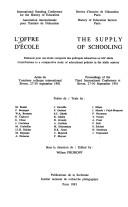| Listing 1 - 3 of 3 |
Sort by
|
Book

ISBN: 2753501335 2753523479 9782753501331 Year: 2015 Publisher: Rennes : Presses universitaires de Rennes,
Abstract | Keywords | Export | Availability | Bookmark
 Loading...
Loading...Choose an application
- Reference Manager
- EndNote
- RefWorks (Direct export to RefWorks)
La colonie de Mettray est la plus célèbre de toutes les institutions pénitentiaires pour enfants et adolescents. En un siècle (1839-1937), elle tente de redresser plus de 17 000 « délinquants » âgés de 6 à 21 ans : les uns ont volé une pomme, les autres commis le seul délit de vagabondage ou encore le crime d'être orphelins… Nichée au coeur de la Touraine, cette entreprise de moralisation par le travail de la terre, cette institution sans mur aux allures de jardin fleuri, donne corps au rêve d'un philanthrope : arracher de petits « innocents coupables » à l'univers fétide des prisons. La Colonie invente ses propres valeurs, ses règles et ses légendes, pour répondre largement aux attentes d'une société toujours prompte à contrôler l'individu. Mais le bel exemple se transforme vite en véritable bagne pour enfants. Punitions, vexations, travaux harassants, tel est le lot quotidien des petits colons de Mettray. L'écrivain Jean Genet, qui y passe près de trois ans, en fait le point de départ de son oeuvre en clair-obscur et le philosophe Michel Foucault l'érige en modèle de l'archipel carcéral. Cet ouvrage offre une utile et passionnante mise en perspective historique des colonies pénitentiaires aux centres éducatifs fermés. Il participe au débat actuel sur la prise en charge d'une enfance indistinctement qualifiée de « coupable », « difficile », « délinquante » ou « surveillée ».
History --- Social Work --- éducation --- délinquance juvénile --- colonie agricole --- Mettray --- Indre-et-Loire --- mineur (enfance) --- détention des mineurs


ISBN: 2859440607 273420004X 9782734200048 9782859440602 9791035104436 Year: 2021 Publisher: Paris : Éditions de la Sorbonne,
Abstract | Keywords | Export | Availability | Bookmark
 Loading...
Loading...Choose an application
- Reference Manager
- EndNote
- RefWorks (Direct export to RefWorks)
Au xixe siècle, l'industrialisation et l'élaboration de politiques éducatives systématiques sont deux phénomènes concomitants, dont seul le premier est ordinairement analysé dans sa dimension internationale. Les politiques scolaires, en revanche, n'ont guère été envisagées jusqu'à présent que dans un cadre étroitement national, pour donner naissance à des stéréotypes et des mythes solidement ancrés dans la conscience collective de chaque pays. En réalité, ces politiques ont revêtu un caractère supranational, qui rend urgente une approche comparée. Seule, une appréciation correcte de la part des différents facteurs nationaux et supranationaux, des motivations éducatives ou étrangères au champ de l’éducation permettra de comprendre leurs conditions d’évolution, leurs chances d’avenir et leurs possibilités de changement. La sélection des communications présentées au Colloque international de Sèvres, tenu en septembre 1981 à l’occasion du centenaire des lois scolaires françaises, que l’on trouvera dans ce livre, veut aider à démêler l’écheveau de ces facteurs et rendre le lecteur conscient de ce qui, dans sa formation intellectuelle et morale, le relie à sa propre nation ou le rend citoyen d’une communauté éducative plus large. In the 19th century, industrialisation and the systematic elaboration of educational policies were two concomitant phenomena; however, only the former is analysed usually in its international dimensions. For educational policies have until now been scarcely considered except front within a strictly national context, aiming to produce stereotypes and perpetuate myths firmly embedded in the collective consciousness of each individual country. In fact, these policies have assumed a supra-national character which urgently calls for a comparative approach. Only a just appreciation of the different factors - national and supra-national - and of the motivations both inside and outside the educational sector, will allow us to understand the…
Education and state --- History --- Congresses. --- Education --- Education policy --- Educational policy --- State and education --- Social policy --- Endowment of research --- History&delete& --- Congresses --- Government policy --- éducation --- politique --- État --- industrialisation --- politique éducative --- scolarité --- communauté éducative --- loi scolaire
Book

ISBN: 3110719878 3110719584 Year: 2022 Publisher: München ; Wien : De Gruyter Oldenbourg,
Abstract | Keywords | Export | Availability | Bookmark
 Loading...
Loading...Choose an application
- Reference Manager
- EndNote
- RefWorks (Direct export to RefWorks)
Gradually the historians of education have broken out of the traditional school museums — which are no longer the sole places to communicate research findings with the wider public — and gone beyond the traditional publication formats. Indeed, they started exploring how to work with the [educational] past in the present, experimenting with presenting the educational past in new ways, and reflecting on how these new forms of mediation and musealisation of sources impacts the research and the (hi)stories told. By zooming in on three themes, musealisation, new ways of exhibiting, and historical storytelling —, this edited volume illustrates the vitality of the history of education, as field of study, and demonstrates its adaptability to the “changing contexts” of its public function. So, rather than being an “endangered species”, the historians of education seem to get fit for the future by showing traditional craftsmanship as well as “engagement with” and “appropriation of” (interdisciplinary) approaches of thinking with the past in the present for wider audiences — stances which are richly illustrated in the various contributions. With respect to public issues, history matters. With the worldwide interest for historical issues related with gender, religion, race, nation, and identity, public history is becoming the strongest branch of academic history. This volume brings together the contributions from historians of education about their engagement with public history, ranging from musealisation and alternative ways of exhibiting to new ways of storytelling.
HISTORY / Study & Teaching. --- Exhibitions. --- History of education. --- Public history. --- Storytelling.
| Listing 1 - 3 of 3 |
Sort by
|

 Search
Search Feedback
Feedback About UniCat
About UniCat  Help
Help News
News